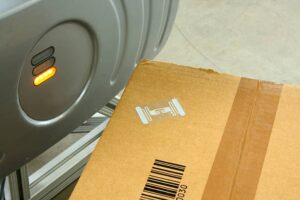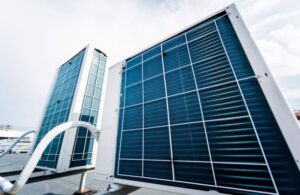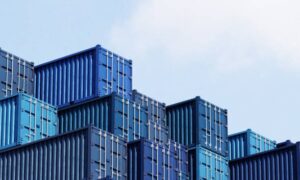Reader hardware (fixed or mobile) sends and receives signals to identify tags. TERTIUM readers also collect received signal strength information to pinpoint tag locations.
RFID tags attach unique electronic identities to physical objects, while an RFID reader decodes this data and sends it off to an external system, such as a computer network or other devices.
The Basics
 RFID systems from www.ramprfid.com/technology/rfid-readers RFID reader can help streamline warehouse or distribution centre operations, but many supply chain managers remain unclear about what exactly RFID stands for and how it operates.
RFID systems from www.ramprfid.com/technology/rfid-readers RFID reader can help streamline warehouse or distribution centre operations, but many supply chain managers remain unclear about what exactly RFID stands for and how it operates.
An RFID reader is at the core of an RFID system, emitting radio waves to read tags containing information and receiving signals back from them. All collected data is transmitted directly into a database either locally or on an offsite server for storage and processing. RFID readers come in various forms – handheld devices for employees to use as needed as well as fixed readers that remain stationary in one spot.
RFID tags come within range of an RFID reader, they broadcast a return signal that contains their unique identification number. When reading such signals, a reader uses standard protocols to understand them and relays this data back into databases or networks where this can be stored as protocol information, managing organisation details, asset description information or serial numbers if applicable. RFID readers may also collect RSS (received signal strength) information from multiple tags in order to estimate location information.
RAIN RFID readers operate at a frequency of around 2.4 GHz, and can be read up to 30 feet away. They are powered either directly by current or induction through magnetic fields and used for tracking shipments, identifying patients in hospital settings, or tracking equipment status on an oil rig.
RFID readers come in various forms and sizes, each tailored specifically to a different application. Handheld readers combine the power of an RFID scanner with wireless networking and multi-protocol RFID capabilities – giving them barcode scanner functionality. Vehicle-mount www.ramprfid.com/technology/rfid-readers RFID reader are embedded into vehicles such as forklifts and trucks to provide hands-free scanning capability without stopping. And fixed readers are mounted permanently in fixed locations in order to read tags as they pass by automatically.
RFID readers utilise radio waves for communication, making them suitable for environments with poor connectivity or obstructions. Unfortunately, however, they are susceptible to interference from metallic objects, and their phase can change with position; as a result, positioning methods relying on RFID-phase measurements have limited accuracy and require expensive hardware devices for accurate measurements.
Types of Tags
RFID systems allow us to identify things such as people and cars using tags. Each tag features a microchip containing an encoded number that communicates with readers using radio waves at specific frequencies. Furthermore, each tag uses its own communication protocol so they can understand each other.
RFID tags operate on three primary frequencies, each having an effect on their read range, attachment materials used and potential applications.
Low Frequency (LF) RFID tags are one of the most frequently used tags, operating between 30 kHz to 300 kHz in frequency range, with approximately 10 cm read distance and providing good resistance against metal, water, or any substances which interfere with radio waves. They’re often employed for access control applications or inventorying items in bars and restaurants.
UHF RFID tags use shorter and higher energy wavelengths that can penetrate through many non-RFID-friendly materials, making them perfect for festivals, concerts and gyms where wristbands may not work well with RFID. They are often used to control access or track items within electron component management systems.
Very High Frequency (VHF) RFID from www.ramprfid.com/technology/rfid-readers RFID reader offer longer and lower-energy wavelengths than UHF ones, making them suitable for tracking goods in warehouses or scanning barcodes in stores, or keeping an item at a specific temperature like food and pharmaceuticals.
Active RFID tags use long-life batteries that enable them to transmit data continuously, unlike passive tags. They may serve as either transponders or beacons and often come equipped with sensors for measuring environmental conditions like vibration/shock/temperature and humidity levels.
Wet Inlays incorporate an RFID microchip and antenna, along with an adhesive backing, into clear polymer or PET/PVT that can be peeled off from a roll and stuck directly onto an object for quick and simple installation.
Applications
RFID technology can be utilized in several different areas, from inventory control and asset tracking, to protecting against shoplifting or employee shrinkage using Electronic Article Surveillance (EAS). RFID tags may be integrated into retail store checkout processes so items with active tags must be paid for; their removal can either be physical removal with special tools or deactivation electronically so the reader will notify of unpaid goods via an alarm signal.
RFID readers connect to antennas, which transmit radio frequency signals that activate RFID tags and intercept responses from them. Read ranges can range anywhere from 4 inches to hundreds of meters depending on the design of both RFID tag and antenna; readers can be handheld, vehicle-mount or fixed.
Handheld RFID readers resemble barcode scanners in appearance but offer more features and are capable of transmitting data over wireless networks to database software. Vehicle-mount readers may be embedded into pallets and other freight handling equipment to automatically log cargo as it moves and loads for transport; fixed readers can be built into walls, ceilings or architectural features of buildings to detect merchandise as it moves or stacks within them.
Active RFID tags from www.ramprfid.com/technology/rfid-readers RFID reader, powered by batteries, can be read at greater distances than passive tags – up to hundreds of feet or further away. While more expensive, active tags have the added advantage of transmitting data back to readers whenever needed.
As RFID is a wireless communication technology, its use by third parties without consent can easily be exploited to gather personal data about its owners – leading to privacy concerns and prompting standard specifications to address them.
RFID systems can help track athletes as they perform physical endurance tests during competitions, and to count how often an athlete completes specific stretches or exercises. This data can then be analysed to analyse effectiveness and find ways to enhance exercise programs.
Cost
RFID (Radio Frequency Identification) is a tracking technology that uses radio waves to identify objects. Like barcode scanning, RFID helps categorize inventory items but offers some distinct advantages over traditional methods of tracking inventory. RFID tags and readers communicate using short-range RF signals and readers can detect signals even without direct line of sight – unlike laser scanners which rely on reflecting light to read barcodes. RFID systems allow businesses to track inventory throughout their supply chains allowing inventory items to be found even if stacked or mixed among products
An RFID reader is a network-connected device with both a scanning antenna and transceiver to capture and process data from RFID tags or wireless sensors. It may be portable for inventory scouting, or installed permanently within warehouse or shipping facility walls such as archways or doorways; in some instances it can even be integrated into forklifts to automatically log the locations of loaded pallets as they move throughout a facility or truck.
RFID readers from www.ramprfid.com/technology/rfid-readers RFID reader scan RFID tags equipped with either passive or active microchips, the latter of which requires no battery power as its energy comes from an RF signal transmitted from an RFID reader. Passive tags can be scanned from distances of 1 inch up to 100 feet depending on their type and the frequency of radio waves that are being sent out by it.
An active microchip can be powered with small amounts of stored energy and pre-programmed with its own tracking identifier and bank of data which can be updated in real-time. Active chips allow greater distance scans than passive tags but are typically more costly.
RFID systems offer many advantages, yet can raise questions as well. There is some concern that RFID could interfere with electronic medical devices and cause electromagnetic interference (EMI), leading to inaccurate readings or malfunctions; however, the FDA has found no such issues with such systems.
 The main character in the newest generation of the Yu-Gi-Oh! He inspires manga and anime series, ARC-V, and the Deck, which includes cards he uses in Duel. This 41-card Deck can be used right out of the box and is tuned to help new Duelists learn to play immediately!
The main character in the newest generation of the Yu-Gi-Oh! He inspires manga and anime series, ARC-V, and the Deck, which includes cards he uses in Duel. This 41-card Deck can be used right out of the box and is tuned to help new Duelists learn to play immediately!
 Installing a ducted air conditioner varies in cost based on the size and configuration of your home as well as whether or not existing ductwork exists. A 5-ton system, for instance, costs more to install than smaller models; to find out what size ducted AC would best suit your home speak with a professional HVAC technician today!
Installing a ducted air conditioner varies in cost based on the size and configuration of your home as well as whether or not existing ductwork exists. A 5-ton system, for instance, costs more to install than smaller models; to find out what size ducted AC would best suit your home speak with a professional HVAC technician today! In the manufacturing industry,
In the manufacturing industry,  RFID systems from
RFID systems from